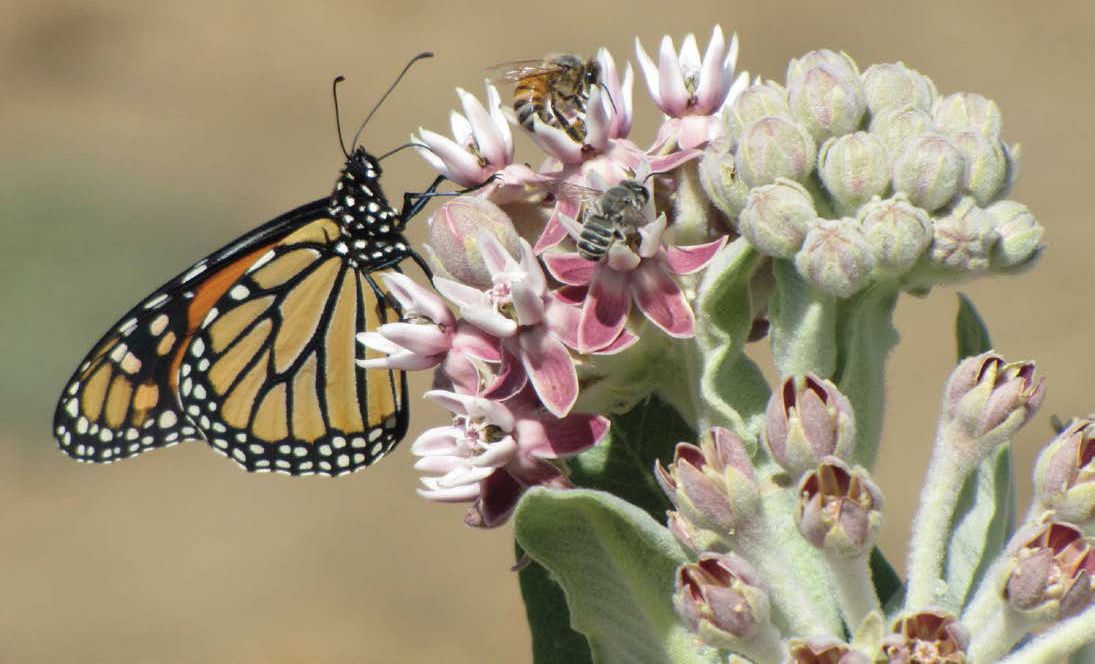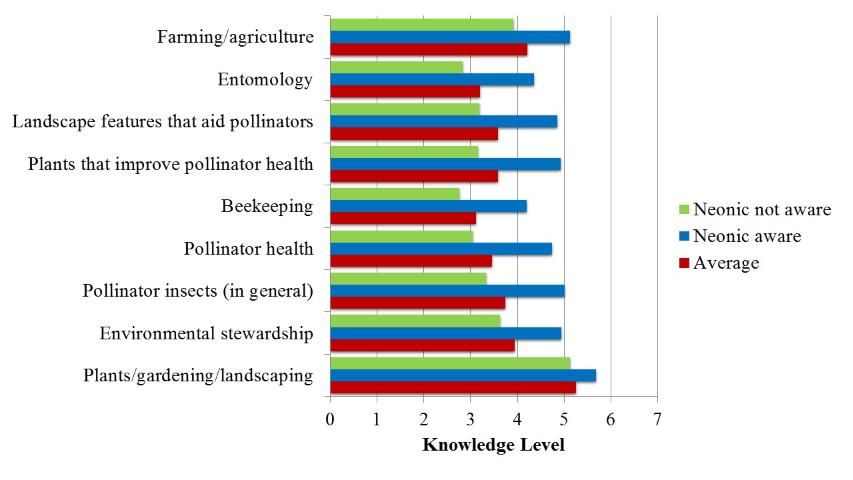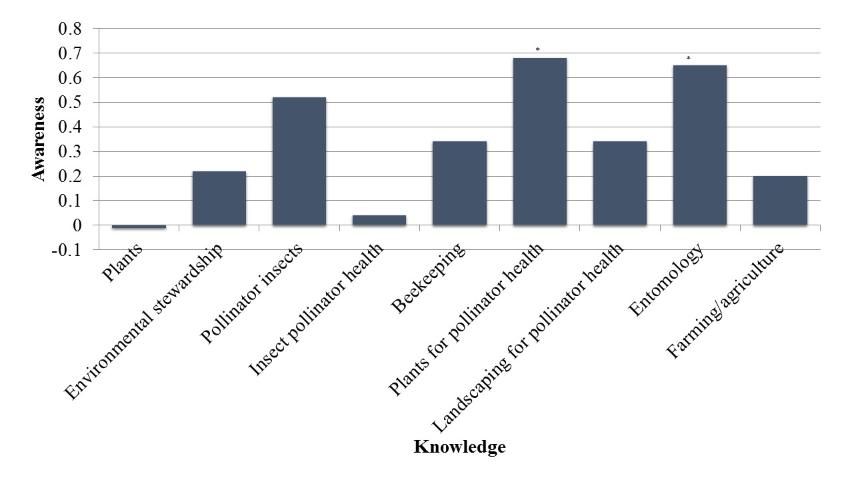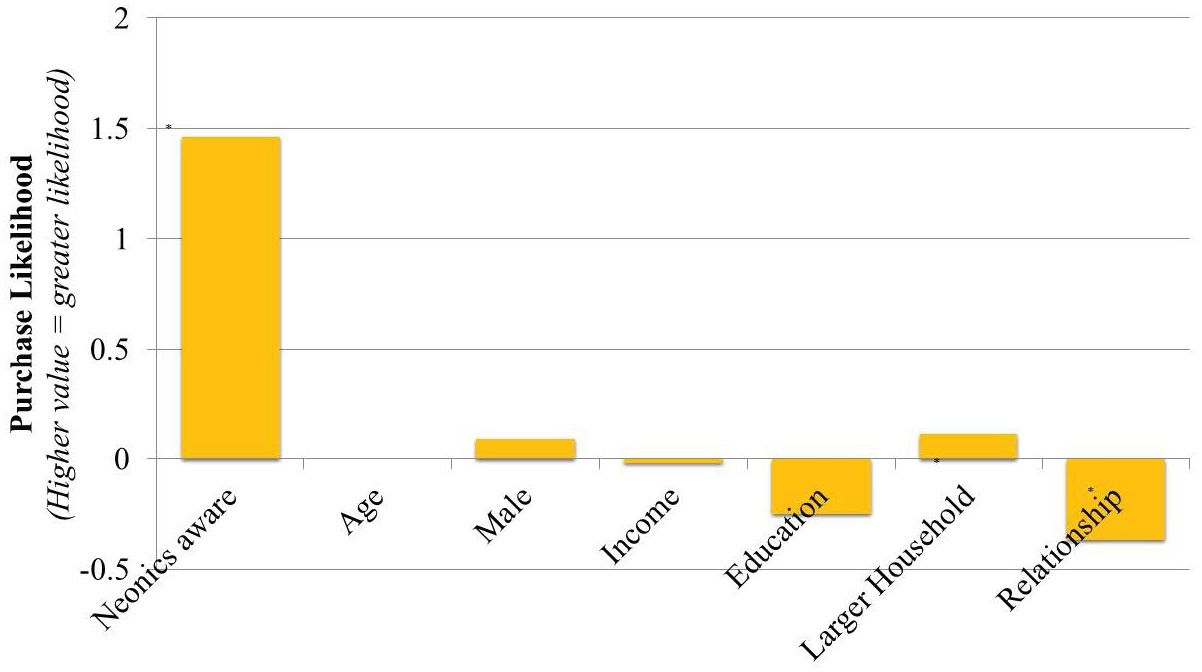Introduction
Neonicotinoid (neonic) pesticides have been facing intense scrutiny from mass media, researchers, governmental agencies, and the general public due to their potential role in pollinator insect population declines (Goulson 2013). Neonic pesticides are systemic, meaning they are within all of the plant's tissues, including nectar and pollen, and may negatively impact pollinator insects that visit those plants for nutrients (Goulson 2013). To date, studies assessing the impact of neonics on pollinator insects are inconsistent (Goulson 2013; Pilling et al. 2013; van der Sluijs et al. 2013; Fairbrother et al. 2014), and the USDA is contemplating mandatory labeling (e.g., "neonic-free" or "treated with neonicotinoids") for certain plants (US-EPA 2013). Nevertheless, research has shown that insecticide use in general has resulted in $284 million per year in damages to honeybee and pollinator services in the United States (Pimentel 2005). This is especially worrying because pollinator insects contribute $171.1 billion per year to world food crop production, and food supply would fail to meet increasing global food demand without pollinator insects (Gallai et al. 2009).

Credit: USDA
In the midst of the neonics controversy, consumer attitudes toward and perceptions of neonics are still being assessed. While previous studies have shown that consumers recognize the need to protect pollinator insects and their habitats (Breeze et al. 2015; Diffendorfer et al. 2014; Mwebaze et al. 2010; Wolleager et al. 2015), studies specifically investigating consumer behavior toward neonic insecticides are scarce. This is likely to change as consumer awareness about neonic insecticides increases (Wolleager et al. 2015). How consumer awareness of neonic pesticides influences their preferences toward plants could provide important insights to growers, retailers, and policy makers as they move forward with neonics-related strategies, legislation, and educational efforts (Rihn and Khachatryan 2016). The next section summarizes our research methodology, followed by the results and a brief summary.
Methodology
An online survey was used to collect data from 921 US consumers who purchased plants within the past 12 months. Respondents indicated whether or not they had heard of neonics at the onset of the experiment. Of the respondents, 24%, whom we designated the "aware group," were aware of neonics, and 76% were unaware of neonics. Additional survey questions asked respondents to indicate their level of knowledge (1=not at all knowledgeable; 7=very knowledgeable) regarding pollinator-related topics (i.e., plants and gardening, landscaping, environmental stewardship, types of pollinator insects, pollinator health, beekeeping, plants that improve pollinator health, landscape features that improve pollinator health, entomology, and farming/agriculture). Respondents finished the survey by indicating their purchase likelihood for plants labeled "neonic-free" and the socio-demographic characteristics (i.e., age, gender, income, education level, household size, and relationship status).
Sample summary statistics are shown in Table 1. The mean age of respondents was 51 years old; 58% were female; 49% had obtained their bachelor's degree or higher; and 74% were in a relationship/married. Most households had 2 to 3 people, and the average household income was between $51,000 and 60,000. When comparing between the aware and unaware groups, the aware group was composed of younger individuals than the unaware group, had a higher percentage of males than the unaware group, was more educated, and had slightly larger households than the unaware group (Table 1). Income differences were not significant between the groups.
Results
Knowledge of Pollinator-Related Topicds
Before conducting the survey, researchers anticipated that consumers who were more knowledgeable about pollinator-related topics would be more aware of neonics. Results showed that, on average, respondents were most knowledgeable about plants/gardening/landscaping, followed by farming/agriculture (Figure 2). They were less knowledgeable (values less than 4) about environmental stewardship, types of pollinator insects, landscape features that aid pollinators, plants that improve pollinator health, pollinator health, entomology, and beekeeping.

Credit: UF/IFAS
Next, researchers assessed if respondents' knowledge of pollinator-related topics influenced their awareness of neonic pesticides. Results showed that consumers who are more knowledgeable about plants that improve pollinator health or entomology were much more likely to be aware of neonics (Figure 3).

Credit: UF/IFAS
Purchase Likelihood for Neonic-Free Plants
Researchers then examined the effect of neonic awareness and respondents' socio-demographics on purchase likelihood for plants labeled as "neonic-free." Unsurprisingly, respondents aware of neonic pesticides were much more likely to purchase a "neonic-free" plant (Figure 4). In addition, respondents with larger households were more likely to purchase "neonic-free" plants. Age, gender, income, and education did not influence purchase likelihood for "neonic-free" plants.

Credit: UF/IFAS
Summary
Consumer awareness of neonic pesticides increases the purchase likelihood for plants that are labeled "neonic-free." In 2016, only 24% of the surveyed respondents were aware of neonic pesticides. As mass media coverage of neonics continues, it is likely consumer awareness will increase. Consequently, as consumer awareness of neonics increases, demand for plants may decrease if there is limited availability of neonic-free options. The results have practical implications for growers, retailers, and policy makers. One way growers, retailers, and policy makers can benefit is through understanding how increased consumer awareness of neonics influences consumers' preferences and purchase intentions. In turn, green industry stakeholders can adjust their production practices, product offerings, educational materials, and promotions based on what end-consumers know and prefer. This is especially important because the results indicate that awareness influences demand. Similarly, policy makers can use this information as they continue to refine regulations that mandate neonic pesticide usage labels on plants. Overall, consumer awareness of neonics is likely to increase (partly due to increasing media coverage), providing an opportunity for the green industry to improve their strategies and educate consumers about neonics to help them make informed decisions.
Based on these results, the following suggestions were developed for green industry stakeholders (growers, wholesalers, retailers, etc.):
- As of 2016, ~24% of consumers are aware of neonic insecticides, and that percentage is likely to increase. Green industry stakeholders can develop educational materials to share with customers about neonic insecticide use, pollinators, and actions customers can take to aid pollinator insects.
- Green industry firms can demonstrate their dedication to aiding pollinator insects by using their online presences (e.g., social media accounts, company websites) and traditional promotions to inform customers about the actions they are currently using to aid pollinator insects (i.e., best management practices in production, selling pollinator friendly plants/products).
- Growers should evaluate their existing pest management strategies and identify economically feasible alternative options to neonics in the event that mandatory labeling occurs or neonics are banned from production in the United States.
References
Breeze, T. D., A. P. Bailey, S. G. Pots, and K. G. Balcombe. 2015. "A Stated Preference Valuation of the Non-Market Benefits of Pollination Services in the UK." Ecological Economics 111:76–85.
Diffendorfer, J. E., J. B. Loomis, L. Ries, K. Oberhauser, L. Lopez-Hoffman, D. Semmens, B. Semmens, B. Butterfield, K. Bagstad, J. Goldstein, R. Widerholt, B. Mattsson, and W. E. Thogmartin. 2014. "National Valuation of Monarch Butterflies Indicates an Untapped Potential for Incentive-Based Conservation." Conservation Letters 7(3):253–262.
Fairbrother, A., J. Purdy, T. Anderson, and R. Fell. 2014. "Risks of Neonicotinoid Insecticides to Honeybees." Environmental Toxicology and Chemistry 33(4):719–731.
Gallai, N., J. M. Salles, J. Settele, and B. E. Vaissiere. 2009. "Economic Valuation of the Vulnerability of World Agriculture Confronted with Pollinator Decline." Ecological Economics 68:810–821.
Goulson, D. 2013. "An Overview of the Environmental Risks Posed by Neonicotinoid Insecticides." Journal of Applied Ecology 50:977–987.
Mwebaze, P., G. C. Marris, G. E. Budge, M. Brown, S. G. Potts, T. D. Breeze, and A. Macleod. 2010. "Quantifying the Value of Ecosystem Services: A Case Study of Honeybee Population in the UK." Proceedings of the BIOECON Conference, Venice, Italy, September 27–28. http://centaur.reading.ac.uk/24838/1/Mwebaze_et_al__2010_UK_honeybee_pollination_valuation.pdf
Pilling, E., P. Campbell, M. Coulson, N. Ruddle, and I. Tornier. 2013. "A Four-Year Field Program Investigating Long-Term Effects of Repeated Exposure of Honey Bee Colonies to Flowering Crops Treated with Thiamethoxam." PLoS ONE 8(10):e77193.
Pimentel, D. 2005. "Environmental and Economic Costs of the Application of Pesticides Primarily in the United States." Environment, Develoment, and Sustainability 7:229–252.
Rihn, A., and H. Khachatryan. 2016. "Does Consumer Awareness of Neonicotinoid Insecticides Influence Their Preferences for Plants?" HortScience 51(4):388–393.
US-EPA. 2013. "Colony Collapse Disorder: European Bans on Neonicotinoid Pesticides." United States Environmental Protection Agency (US-EPA), Washington, DC.
van der Sluijs, J. P., N. Simon-Delso, D. Godson, L. Maxim, J. M. Bonmatin, and L. P. Belzunces. 2013. "Neonicotinoids, Bee Disorders, and the Sustainability of Pollinator Services." Current Opinion on Environmental Sustainability 5:293–305.
Wollaeger, H. M., K. L. Getter, and B. K. Behe. 2015. "Consumer Preferences for Traditional Neonicotinoid-Free, Bee-Friendly, or Biological Control Pest Management Practices on Floriculture Crops." HortScience 50(5):721–732.